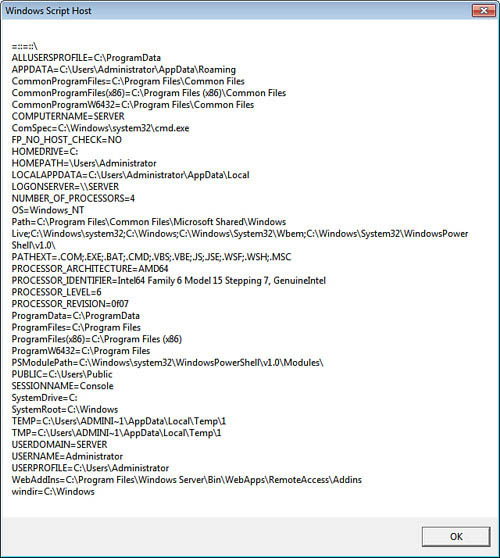5. Working with Registry Entries
The Registry
is one of the most crucial data structures in Windows. However, Windows
isn’t the only software that uses the Registry. Most 32-bit
applications use the Registry as a place to store setup options,
customization values the user selected, and much more. Interestingly,
your scripts can get in on the act as well. Not only can your scripts
read the current value of any Registry setting, but they can use the
Registry as a storage area. This enables you to keep track of user
settings, recently used files, and any other configuration data that
you’d like to save between sessions. This section shows you how to use
the WshShell object to manipulate the Registry from within your scripts.
Reading Settings from the Registry
To read any value from the Registry, use the WshShell object’s RegRead method:
WshShell.RegRead(strName)
| WshShell | The WshShell object. |
| strName | The name of the Registry value or key that you want to read. If strName\), RegRead returns the default value for the key; otherwise, RegRead returns the data stored in the value. Note, too, that strName must begin with one of the following root key names: ends with a backslash ( |
| | Short Name | Long Name |
| | HKCR | HKEY_CLASSES_ROOT |
| | HKCU | HKEY_CURRENT_USER |
| | HKLM | HKEY_LOCAL_MACHINE |
| | N/A | HKEY_USERS |
| | N/A | HKEY_CURRENT_CONFIG |
The script in Listing 3 displays the name of the registered owner of this copy of Windows.
Listing 3. A Script That Reads the RegisteredOwner Setting from the Registry
Set objWshShell = WScript.CreateObject("WScript.Shell")
strSetting = "HKLM\SOFTWARE\Microsoft\Windows NT\CurrentVersion\RegisteredOwner"
strRegisteredUser = objWshShell.RegRead(strSetting)
WScript.Echo strRegisteredUser
|
Storing Settings in the Registry
To store a setting in the Registry, use the WshShell object’s RegWrite method:
WshShell.RegWrite strName, anyValue [, strType]
| WshShell | The WshShell object. |
| strName | The name of the Registry value or key that you want to set. If strName\), RegWrite sets the default value for the key; otherwise, RegWrite sets the data for the value. strName must begin with one of the root key names detailed in the RegRead method. ends with a backslash ( |
| anyValue | The value to be stored. |
| strType | The data type of the value, which must be one of the following: REG_SZREG_EXPAND_SZ, REG_DWORD, or REG_BINARY. (the default), |
The following statements create a new key named ScriptSettings in the HKEY_CURRENT_USER root:
Set objWshShell = WScript.CreateObject("WScript.Shell")
objWshShell.RegWrite "HKCU\ScriptSettings\", ""
The following statements create a new value named NumberOfReboots in the HKEY_CURRENT_USER\ScriptSettings key and set this value to 1:
Set objWshShell = WScript.CreateObject("WScript.Shell")
objWshShell.RegWrite "HKCU\ScriptSettings\NumberOfReboots", 1, "REG_DWORD"
Deleting Settings from the Registry
If you no longer need to track a particular key or value setting, use the RegDelete method to remove the setting from the Registry:
WshShell.RegDelete(strName)
| WshShell | The WshShell object. |
| strName | The name of the Registry value or key that you want to delete. If strName\), RegDelete deletes the key; otherwise, RegDelete deletes the value. strName must begin with one of the root key names detailed in the RegRead method. ends with a backslash ( |
To delete the NumberOfReboots value used in the previous example, you would use the following statements:
Set objWshShell = WScript.CreateObject("WScript.Shell")
objWshShell.RegDelete "HKCU\ScriptSettings\NumberOfReboots"
6. Working with Environment Variables
Windows Home Server keeps track of a number of
environment variables that hold data, such as the location of the
Windows folder, the location of the temporary files folder, the command
path, the primary drive, and much more. Why would you need such data?
One example would be for accessing files or folders within the main
Windows folder. Rather than guessing that this folder is C:\Windows, it would be much easier to just query the %SystemRoot%
environment variable. Similarly, if you have a script that accesses
files in a user’s Documents folder, hard-coding the username in the
file path is inconvenient because it means creating custom scripts for
every possible user. Instead, it would be much easier to create just a
single script that references the %UserProfile% environment variable. This section shows you how to read environment variable data within your scripts.
The defined environment variables are stored in the Environment collection, which is a property of the WshShell object. Windows Home Server environment variables are stored in the "Process" environment, so you reference this collection as follows:
WshShell.Environment("Process")
Listing 4 shows a script that runs through this collection, adds each variable to a string, and then displays the string.
Listing 4. A Script That Displays the System’s Environment Variables
Option Explicit
Dim objWshShell, objEnvVar, strVariables
Set objWshShell = WScript.CreateObject("WScript.Shell")
'
' Run through the environment variables
'
strVariables = ""
For Each objEnvVar In objWshShell.Environment("Process")
strVariables = strVariables & objEnvVar & vbCrLf
Next
WScript.Echo strVariables
|
Figure 3 shows the dialog box that appears. (The environment variables in your version of Windows Home Server may be different.)

If you want to use the value of a particular environment variable, use the following syntax:
WshShell.Environment("Process")("strName")
| WshShell | The WshShell object |
| strName | The name of the environment variable |
Listing 4 shows a revised version of the script from Listing 1 to create a shortcut. In this version, the Environment collection is used to return the value of the %UserProfile% variable, which constructs the path to the current user’s Desktop folder, as well as the %SystemRoot% variable, which constructs the paths for Notepad and the hosts file.
Listing 4. A Script That Creates a Shortcut File Using an Environment Variable
Option Explicit
Dim objWshShell, strUserProfile, strSystemRoot, objShortcut
Set objWshShell = WScript.CreateObject("WScript.Shell")
strUserProfile = objWshShell.Environment("Process")("UserProfile")
Set objShortcut = objWshShell.CreateShortcut(strUserProfile & _
"\Desktop\Edit Hosts File.lnk")
strSystemRoot = objWshShell.Environment("Process")("SystemRoot")
With objShortcut
.TargetPath = strSystemRoot & "\Notepad.exe"
.Arguments = strSystemRoot & "\System32\Drivers\etc\hosts"
.WorkingDirectory = "C:\"
.Description = "Opens the hosts file in Notepad"
.Hotkey = "Ctrl+Alt+7"
.IconLocation = strSystemRoot & "\System32\Shell32.dll,18"
.WindowStyle = 3
.Save
End With